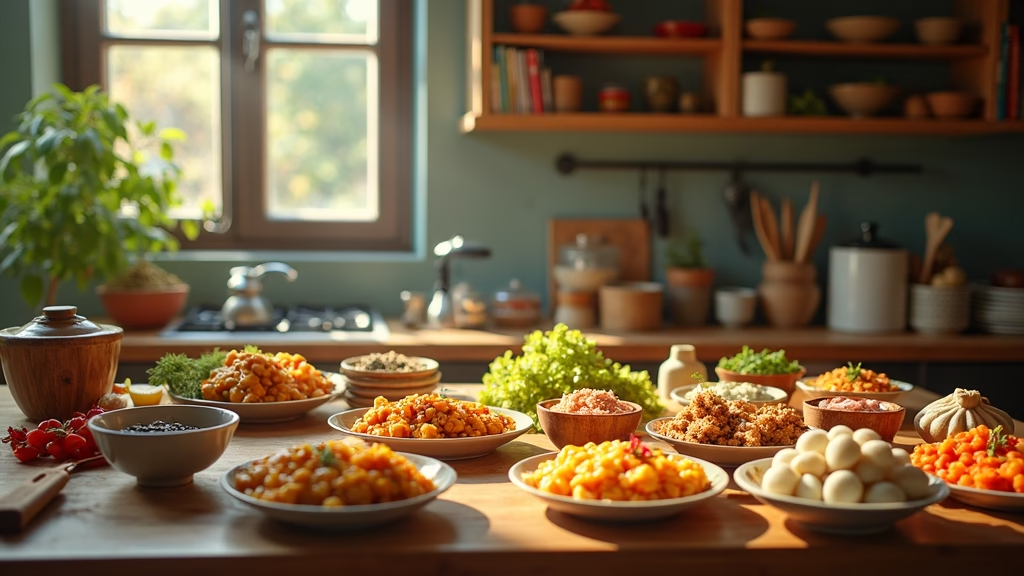Explore Global 2025 Food Trends: Tradition Meets Innovation
Your Daily FoodScope for June 12, 2025
Unpacking the culinary landscape
Ladies and gentlemen, as we embark on an exploration of the food trends heralded for June 2025, we find ourselves at the intersection of tradition and innovation. The landscape of our dining tables is evolving at an unprecedented pace, offering a rich tapestry woven with the colors of different cultures, sustainability urges, and the latest scientific advancements in nutrition. In a world still reeling from the impacts of the pandemic, our relationship with food has transformed dramatically, ushering in a fresh wave of interest that can only be characterized as both vibrant and deeply introspective.
Key food trends defining 2025
In this tapestry of food culture, international snacking stands out as a notable trend. The mundane act of snacking becomes a passport to global flavors, allowing us to taste the essence of distant lands from the comfort of our homes. Consumers are increasingly seeking to experience diverse cultures through their food choices, and brands are responding by offering unique, cross-cultural snacks that surprise and delight the palate. This appetite for international flavors invites us into a broader family of tastes, transcending borders and enriching our collective culinary experience.
A significant element we cannot overlook is the rise of adaptive dumplings. These culinary creations are not mere transporters of filling; instead, they embody a transformative approach to traditional recipes. Imagine a soft, delicate shell infused with flavors inspired by global cuisines. As we adapt these beloved dumplings to reflect not just flavors but also textures, we unveil a new chapter in comfort food—one that adapts and embraces personal tastes and cultural narratives.
Moreover, focusing on texture innovation is redefining how we perceive our food’s appeal. As more consumers gravitate towards food that engages more than just the taste buds, chefs and food scientists are pushing the boundaries to create experiences that excite our senses. The interplay of crunch and creaminess, for instance, adds a layer of satisfaction that extends beyond the act of eating itself. Our craving for multi-sensory experiences is transforming how we approach meal preparation and consumption.
Another compelling aspect is the hyperbolic trend of hydration. As health consciousness reaches an all-time high, consumers are avidly pursuing products that not only satisfy hunger but also contribute to their overall well-being. As a result, we see a flourish of products promising enhanced hydration—sparkling waters infused with exotic fruits, nutrient-packed smoothies, and even powders designed to maximize hydration benefits during meals. This newfound focus on hydration reflects our collective understanding of the vital role water plays not just in nutrition but also in holistic health.
Quality over quantity
As our culinary preferences evolve, the quality of ingredients remains paramount. People are increasingly drawn to produce that boasts high nutrient density, organic origins, and a sustainability narrative. A recent survey** indicates that over 70% of consumers now prioritize healthy eating choices, favoring ingredients that speak to their values and dietary aspirations. From farm-to-table initiatives to the cultivation of heirloom varieties, the narrative of how our food reaches us is more important than ever.
The pandemic served as a pivotal moment, opening our eyes not just to what we eat but how we prepare and consume food. Traditional cooking practices received a revival, with many flocking to their kitchens to experiment with techniques that honor the past while embracing modern flavor profiles. This trend towards homemade meals, comfort foods, and the nostalgia they evoke reminds us that food is about connection—both to our history and to one another.
The concept of gut health has surged in significance post-pandemic. With an increasing understanding of how our microbiome influences overall health, the demand for products rich in probiotics and fibers has skyrocketed. From fermented foods to fiber-enriched snacks, consumers are on a quest for products that promote not just taste but well-being. The encouragement of happy gut bacteria is now sweetened with the promise of improved mood and immunity.
Examples of innovation in food products
Take, for instance, the innovative launches making waves this year. Products like Chex Mix OREO Cookies & Cream Muddy Buddies exemplify enticing flavor combinations that pique curiosity and ignite nostalgia. Similarly, the introduction of Pabst Blue Ribbon Beer Flavored Cheese showcases the intriguing intersection of beverages and beloved comfort food, offering a nod to casual gatherings, where flavor hijinks reign supreme. These products reflect a daring wave of culinary creativity that seeks to challenge the norms of food.
Equally compelling is the rise of East Asian cuisine in mainstream ingredients and dishes. The National Restaurant Association underscores a growing love for Korean, Vietnamese, and Filipino fare as we venture into 2025. Dishes once thought of as regional specialties are now making their way onto menus across the country, creating a fusion that both honors traditions and offers exciting new interpretations.
The implications of these culinary trends reach far beyond mere indulgence. They serve as reflections of who we are as individuals and a society. With the world continuing to change, our dining experiences encapsulate resilience, adaptability, and a commitment to the stories that our food tells.
For more captivating insights into the culinary world, don’t hesitate to check out the latest updates on Newsmagazine.
Emphasizing health and sustainability
As our journey through the culinary trends of 2025 deepens, the ever-present themes of health and sustainability emerge as guiding principles. The post-pandemic world has galvanized consumers’ commitment to supporting local farmers and environmentally conscious brands, reshaping how we view the origin of our food. This fundamental shift echoes a growing awareness that our food choices are not merely personal—they are global decisions that reverberate throughout our communities and the planet.
Local sourcing and ethical consumption
The call for local sourcing echoes louder than ever, as consumers actively seek out products that marry quality with sustainability. Farmers’ markets and community-supported agriculture programs are flourishing, allowing individuals to connect with the sources of their sustenance. Shoppers are increasingly prioritizing seasonal produce, selecting fruits and vegetables at their peak, effectively enhancing both flavor and nutrition while diminishing the carbon footprint associated with long-distance transportation. Each choice we make at the grocery store becomes an opportunity to champion ethical consumption—supporting farmers who engage in environmentally sound practices and promoting biodiversity.
Equally vital is the burgeoning awareness surrounding plant-based diets. More than a fad, plant-based eating has grown into a lifestyle that champions sustainability alongside profound health benefits. In 2025, we are witnessing a surge in innovative meat substitutes, crafted to satiate not just hunger but also the ever-evolving palate. Products such as lab-grown meats and chickpea-based snacks are not merely alternatives; they enable consumers to enjoy their favorite flavors without the ethical quandaries tied to traditional meat production. This movement encourages a shift in mindset—an understanding that food choices can simultaneously be enjoyable and responsible.
The role of technology in culinary trends
In this time of rapid change, technology also plays a pivotal role. The introduction of smart kitchen appliances and apps that cater to personalized nutrition not only simplify meal prep but also elevate our food experiences. Recipe generators tailored to individual dietary needs provide invaluable assistance, promoting creativity and helping home cooks maximize the utility of seasonal ingredients. As technology continues to evolve, the confluence of gastronomy and innovation promises to redefine our approach to cooking, helping weave together tradition and modernity.
As we dissect the rich layers of culinary trends anticipated for June 12, 2025, it becomes evident that our dining experiences intricately embody the larger narratives that shape our society. Whether steeped in nostalgia or propelled by forward-thinking innovations, every bite connects us—forming a crucial bridge between generations, cultures, and communities.
The bottom line
The food trends emerging in 2025 are a testament to our resilience and adaptability as a society. They remind us of the stories food can tell, integrating heritage with experimentation, ethics with indulgence. As we reflect on the blend of flavors that await us, we see the culinary landscape not just as a menu of options, but as an ongoing conversation about who we are, what we value, and how we wish to shape our world.
In this age of evolving tastes and preferences, let’s embrace the opportunities ahead, ready to savor the rich, diverse dialogues that our plates will serve us as we venture deeper into the unfolding chapters of our culinary future.
For further updates on the latest food trends, stay tuned to daily insights at Your Daily FoodScope and subscribe to our channel for fresh news at Завжди свіжі новини.
latest video
news via inbox
Subscribe to the latest news in the world of politics and technology







